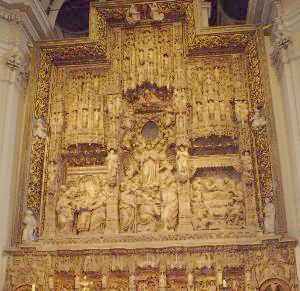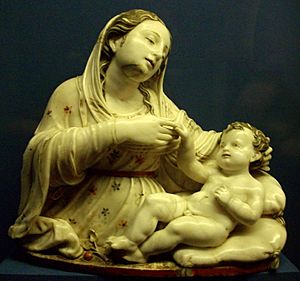Damià Forment facts for kids

Damià Forment (born around 1475-1480 in Valencia, Spain – died 1540 in Santo Domingo de la Calzada) was a very important Spanish artist. He was an architect and a sculptor. Many people think he was the most important Spanish sculptor of the 1500s.
Forment studied art in famous cities like Rome and Florence in Italy. After his studies, he returned to his hometown of Valencia. He worked there from 1500 to 1509. Then, he moved to Zaragoza, where he set up his main workshop. He stayed there for the rest of his life. A sculptor named Juan de Salas was one of his students. Juan de Salas later helped Forment carve beautiful figures from wood and alabaster.
Forment's first big project was the altar of the Basilica of Our Lady of the Pillar. This altar was made from alabaster between 1509 and 1512. It mixed both Gothic and Renaissance art styles. When the old church was taken down, this altar was saved. It was then placed in the new church built in the 1600s. Forment also created altarpieces for other churches. These include the churches of San Miguel de los Navarros and San Pablo in Zaragoza. He also made the altar for the cathedral of Huesca (1520–1524). This one was in the Mannerist style. His work for the Poblet Monastery (1527) was his first piece completely in the Renaissance style. His very last work was the Renaissance altar for the Cathedral of Santo Domingo de la Calzada (1537–1540).
Contents
About Damià Forment's Life
Damià Forment got married in Valencia in 1499. His wife was Jerónima Alboreda. They had four daughters together. In 1509, he moved to Zaragoza. This move was for his first major project. It was the altarpiece for the Basilica del Pilar in Zaragoza. This altarpiece was designed to be like the Gothic altarpiece in the Seo cathedral. It also focused on the Virgin Mary.
Forment created two more altarpieces for Zaragoza. These were for the Church of San Pablo and San Miguel de los Navarros. His second big project was for the cathedral of Huesca. He worked on this between 1520 and 1534. This altarpiece was very similar to the one in the Basilica del Pilar. It showed three main scenes: the way to Calvary, the Crucifixion, and the Descendimiento (taking Christ down from the cross).
Forment's Workshop and Patrons
Damià Forment set up a very important workshop in Zaragoza. Many students and apprentices worked there. Over twenty-five altarpieces were made in this workshop. One of his most important supporters was Bishop Jaime Conchillos. The Bishop was from Aragon. He ordered several altarpieces for Zaragoza. This included one for his family's burial chapel. He also ordered one for his hometown of Tarazona. At one point, Forment had three workshops. One was in Zaragoza, another in Huesca, and a third in Tarragona.
The Poblet Monastery Altarpiece
One of Forment's most famous works is the altarpiece for the Poblet Monastery. This monastery is in Tarragona. The abbot Caixal asked him to make it. It was made from white alabaster. Forment worked on it between 1527 and 1529. Many people helped him with this large project. The altarpiece has four main horizontal parts. The very top shows a scene of suffering. The first and third parts show scenes from the life of Christ. These are carved in relief within shell-shaped niches. The fourth part features the twelve apostles. The central figure is the Saviour. The second part is dedicated to the Virgin Mary. Her sculpture is the main one on the altar. She is surrounded by saints.
There were some disagreements about this altarpiece. Some people said he did not use good marble. Others claimed there were problems with the size of the decorations. They said it did not match the contract. Today, this altarpiece has been restored. It is considered the most important Renaissance work at Poblet Monastery.
Later Life and Death
Damià Forment was working on the altarpiece for the Cathedral of Santo Domingo de la Calzada when he died. He had started this wooden altarpiece in 1537. Forment left behind many students and followers. These included Juan de Salas and his son, Felipe Gregorio Pardo Vigarny. Forment passed away in Santo Domingo de la Calzada in 1540.
Main Works by Damià Forment
Here are some of the important works created by Damià Forment:
- Altarpiece for the Basilica del Pilar in Zaragoza (1509).
- Altarpiece of St. Eloy in Valencia (1509). He made this with his brother Onofre.
- Altarpiece for San Pablo in Zaragoza (1511).
- Our Lady of the Chorus in Zaragoza (1515).
- Altarpiece for San Miguel de los Navarros in Zaragoza (1518).
- Altarpiece for the Cathedral of Huesca (1520-1534).
- Piety (1522-1525).
- Adoration of the Shepherds in Sobradiel, Zaragoza (1520-1530).
- La Magdalena in Tarazona, Zaragoza (1524).
- Altarpiece for Poblet Monastery in Tarragona (1527).
- Altarpiece of Santiago in Bolea, Huesca (1532).
- Altarpiece for the Cathedral of Santo Domingo de la Calzada (1537).
- May Altarpiece for the Parish Church of Sallent de Gallego, Huesca (1537).
- Between 1523 and 1525, he worked on projects in Aragon. These included a processional bust of Santa Barbara in Épila.
- Altarpiece for the Cathedral of Saint Mary of the Assumption of Barbastro, Huesca (1560). Forment died before finishing this. Other artists completed it in 1602.
See also
In Spanish: Damián Forment para niños
- Renaissance sculpture in Spain
- Renaissance sculpture in Aragon


